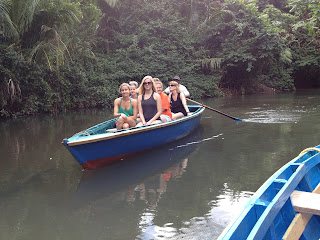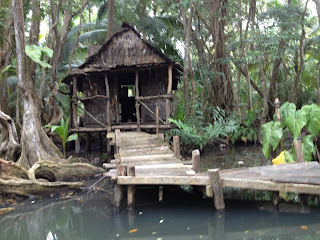As I've previously written, Peace Corps Volunteers (PCVs) around the world are not allowed to operate a motor vehicle. We must “make do” with the local transportation system, which in my case means various vans that operate on routes Monday through Friday, with lesser coverage on Saturday, and virtually none on Sunday.
However, some of my colleagues came up with a way for us to take a driving tour of parts of the island last Saturday. The local boyfriend of one of the PCVs rented a van and drove it, so we could do our own little tour. It was fun to ride around with a van full of your friends, rather than sharing a bus ride with total strangers.
That's me with four of my colleagues sitting under a rock overhang near the crashing surf during our visit to L'Escalier Tete Chien, described further below.
We got off to a late start (as typically happens with so many folks involved, all coming from different directions). Our first stop was for a snack at this beach.
Then we headed into the Kalinago Territory, which is a 3700 acre area that the British reserved for the Carib natives who had originally inhabited Dominica (Kalinago is now the preferred term for this indigenous tribe). It has a population of about 3,000 descendents of Dominica's original inhabitants, ruled by a chief, and the land is owned communally. They don't like the term “Indian reservation,” but there is a similarity. It is one of the only—and the largest (by far)—community of natives in the Caribbean. The rugged, mountainous lands in this isolated area allowed them to maintain their culture.
Our destination was the L'Escalier Tete Chien, which roughly translates into the stairway of the dog's head. This name has nothing to do with dogs, but instead with snakes. While Dominica does not have any poisonous snakes, there are a few boa constrictors. Someone thought that these snakes appeared to have a head shaped similarly to a dog's head, thus their name became Tete Chien (head, dog). [By the way, I get the impression that there are very few boa constrictors on this island, and those that are here are likely deep in the interior and not around my little coastal village—besides, I'd rather take my chances with a boa any day, compared to the copperheads we have back home.]
The L'Escalier Tete Chien is a peninsula jutting out into the Atlantic Ocean, which was formed by a lava flow. There is a native legend that a giant boa constrictor swam from South America and came ashore at this point, continuing up the hill to a cave near the top of the mountain. The lava flow where it entered the sea, and where the serpent supposedly emerged, reminds some folks of a staircase, hence the name (below shows some of us working our way down to the ocean).
Regardless of the accuracy of this legend, there are plenty of beautiful views here (including a view of a major landslide which likely occurred during Tropical Storm Erika—see the picture below). I especially enjoyed watching the powerful waves crashing against the rocky shoreline from underneath the rock overhang shown in the first picture in this story.
After our hike, we headed down to Castle Bruce, where we enjoyed a picnic at this beach.
We then left the Atlantic side and crossed the interior of the island to the capital of Roseau on the Caribbean side. Unfortunately, we did not have time to stop at Emerald Falls even though we drove by it. We wanted to get to the Caribbean side so that we could watch the sun setting into the sea.
Upon arrival, we drove to the top of a nearby hill known as Jack's Bluff. It provided an impressive view of Dominica's capital city. A huge Carnival cruise ship was docked downtown that day. You can see it in the lower left corner of the picture below, as well as the cricket stadium in the upper right corner. In the foreground below our perch on the hill is the Botanical Gardens. Unfortunately, clouds prevented a nice sunset picture.
We topped off our driving tour with a quick little night time swim at Mero Beach (too dark for pictures) on the way home. All in all, it was a fun day exploring my island with my Peace Corps friends.






























